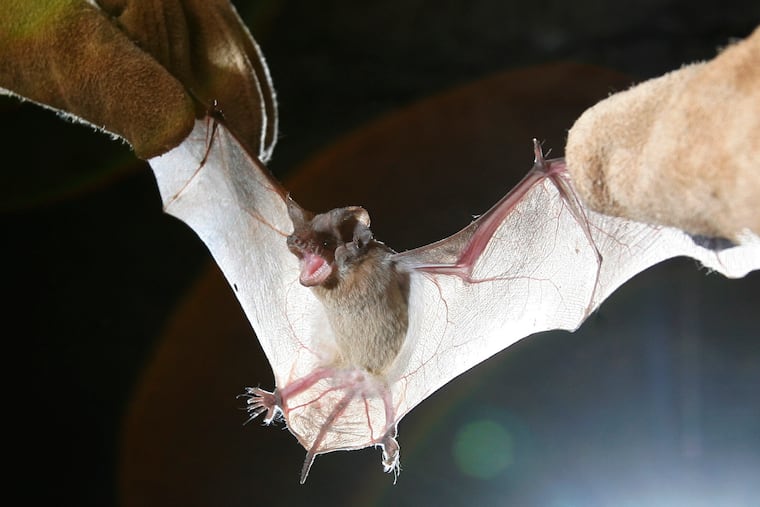Hello, August. So long, bats.
Bats are a protected species that cannot be disturbed from May through July. Come August, though, it's fair game to shoo them out of your house — much to the relief of Kathleen O'Brien.

Welcome to August, or as I like to think of it, Bat Eviction Month.
Earlier this summer, we noticed some odd droppings on the balcony off of our master bedroom. I texted a photo to the local exterminator, who gave his instant verdict: Bats were living in the sealed crawl space of our addition.
And there was nothing we could do about it.
Bats are a protected species that cannot be disturbed during their breeding season, or roughly May through July, he explained. Once that’s over, in August, he could cover the small gap they’d used with special netting that would allow Ma, Pa, and Junior Bat to leave, but not return. Until then, though, they got to hang out about 10 feet above my bed.
My response: “You’re kidding, right?”
My approach to bats in my house can be summed up thusly: Mi casa es mi casa. Get your own casa.
I willingly share our little property with deer, rabbits, foxes, and the occasional bear. I’ve stopped traffic to help the fawns cross the street. Some mornings the place looks so much like the forest scene in Snow White and the Seven Dwarfs that I expect all the critters to break out in song.
But here’s an important distinction: Those animals have the good manners to live elsewhere. For all the talk of humans encroaching on wildlife habitat, Ma and Pa Bat are encroaching on my habitat. My house was built in 1947. Bats have an average lifespan of about 16 years. Do the math. My creepy little tenants are squatters.
At one point, my husband, eyes gleaming with the prospect of a woodworking project, suggested coaxing them out by constructing a bat house and mounting it on a nearby tree.
The exterminator shook his head sadly and said, “If you already had a nice, warm, rent-free apartment ... would you move?”
And so we waited, knowing bat guano was collecting under our roof, baking in a heat wave. (Apologies to anyone eating right now.)
Yet, I can find zero government validation of my disgust. Bats, while nocturnal, are having their moment in the sun, so to speak. They are victims of a terrible fungus that has decimated them, hence their designation as a protected species. That means everything you read about them these days is decidedly pro-bat.
“Bats are beneficial animals,” states the Pennsylvania Department of Conservation and Natural Resources. That’s because a single bat can eat a million mosquitoes a year. New Jersey Fish and Wildlife calls them “misunderstood, feared and unfairly persecuted.” The New Jersey Department of Health tries to put a good spin on things with this priceless line: “They almost never get tangled in people’s hair.”
Translation: Sometimes they actually do get tangled in people’s hair.
The unspoken message: If you dislike bats, you’re simply ill-informed.
Even the very word exterminator has been airbrushed out of the vocabulary when it comes to bats. (Granted, it does sound a little murdery, but when it comes to pest control, isn’t that kind of the point?) Now they are called “excluders.” At the proper time of year, your local “excluder” may “exclude” the bat from your house, much as if your home were a trendy nightclub.
So ingrained is my disgust of bats that the one time I saw one inside my house, peacefully sleeping upside down from the ceiling in my den, the mere sight of it apparently gave me the power of flight. Seconds after spotting it, I was in the middle of the street with no memory of my feet having touched the ground.
Bat-lovers will say my fear of bats is an acquired trait.
To which I respond: “Yeah, I acquired it by reading.”
Bats can carry rabies. The last death from rabies acquired in New Jersey, in 1997, was from a bat bite. The list of bacterial pathogens that can be in bat guano reads like a rogues’ gallery of illnesses, from salmonella to staphylococcus.
They can spread so-called zoonotic illnesses — diseases that hop species, often with deadly results. Marburg hemorrhagic fever, anyone? If memory serves, bats were the suspected culprit in both the origins of the SARS outbreak of 2003 and, hello, COVID-19.
In short, I feel confident I’m not crazy for wanting them gone from my house. Their nightly routine of eating their fill of mosquitoes is helpful, to be sure. All I’m asking is for them to set up a different base of operations.
In, say, my neighbor’s crawl space?
Kathleen O’Brien is a retired newspaper columnist whose habitat is northwest New Jersey.